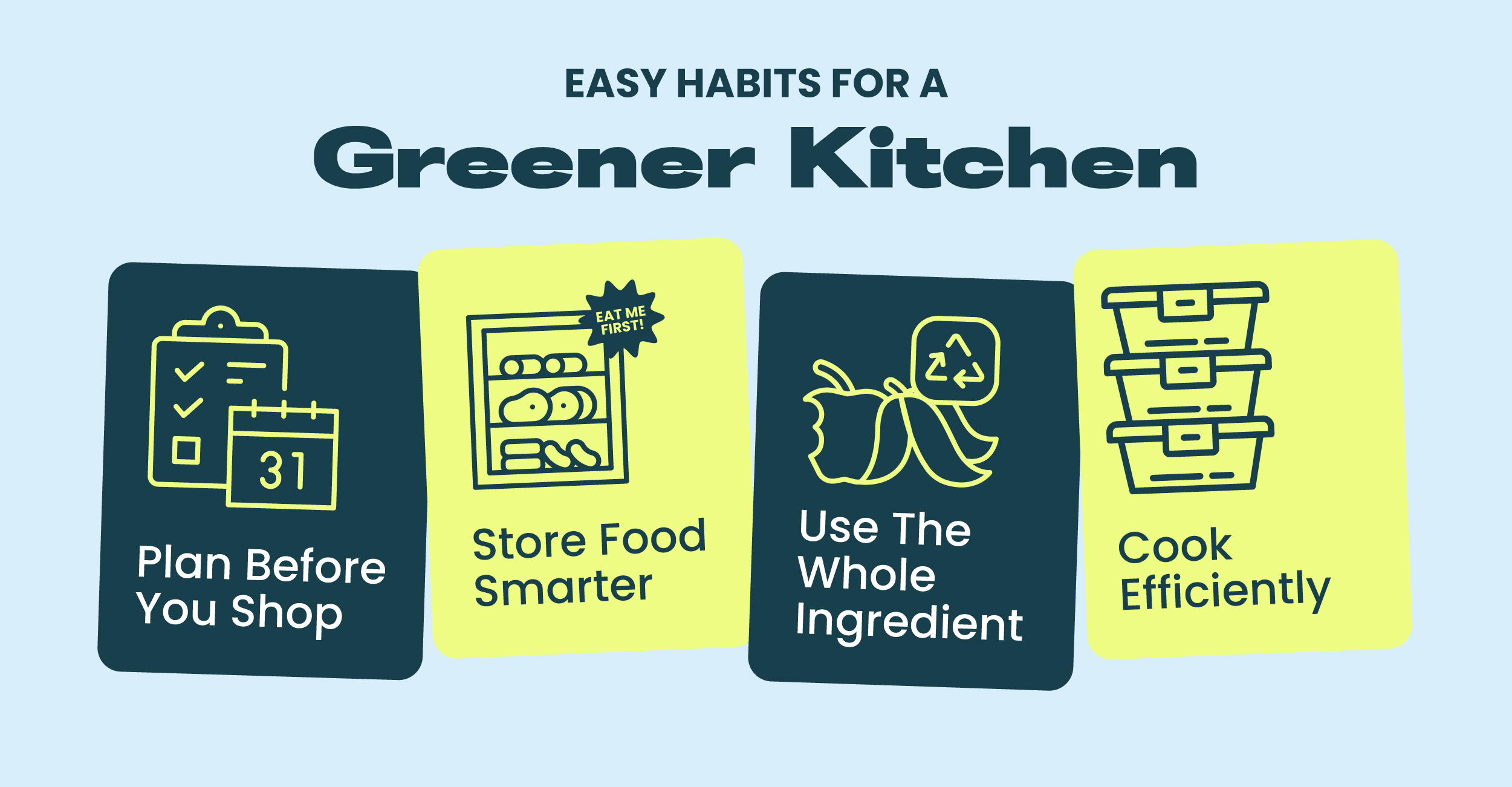
Eco-friendly cooking isn’t just a buzzword, it’s becoming a kitchen essential. According to Carbon Brief, food systems contribute roughly 34% of global greenhouse gas emissions through agriculture, land use, and supply chain activities. In the U.S., the USDA estimates that 30 to 40 percent of the food supply is wasted, about 133 billion pounds and $161 billion in losses annually.
With climate concerns rising and food systems under pressure, how we cook at home can have a significant impact. For food brands, marketers, and creators, this shift presents both a responsibility and an opportunity. Whether it’s reducing food waste or choosing seasonal produce, sustainable cooking habits are easier to adopt than you might think.
Food systems account for over a third of global greenhouse gas emissions. But change doesn’t only start on the farm - it begins on your countertop. Home cooks hold the power to reduce waste, conserve energy, and influence demand for more sustainable ingredients. Best of all, what’s good for the planet often tastes even better. Fresh, seasonal, low-waste meals are not just sustainable-they’re satisfying.
Shopping at farmers' markets or choosing locally grown produce reduces the emissions tied to food transport. Eating with the seasons also means better flavor, nutrition, and cost-efficiency.
Explore more on this in SideChef's Reducing Food Waste at Home, which dives deeper into planning and preservation. Even simple steps-like keeping a list before shopping or using older ingredients first-can significantly cut waste. Composting helps too.
SideChef’s Healthy Eating Habits offers more ideas on aligning nutrition and sustainability. Shifting to plant-based doesn’t mean abandoning your favorites-it can be as simple as swapping ground beef for lentils in tacos or using oat milk in your morning coffee. These swaps not only reduce emissions but often introduce exciting new flavors and textures.

Making mindful choices at the grocery store doesn’t just save time and money—it also helps reduce waste and support a more sustainable lifestyle. A little preparation goes a long way toward building smarter habits in the kitchen and beyond. By planning ahead and being intentional about what you buy, you can minimize food waste, cut down on unnecessary packaging, and avoid the stress of last-minute decisions. Here are a few simple strategies to help you shop smarter and more sustainably:
Proper storage can significantly extend the life of your food and reduce waste. Freeze leftovers or extra portions of meals to enjoy later, and be sure to label and date them so nothing gets forgotten in the back of the freezer. Create an “Eat Me First” bin in your fridge to highlight items that are close to expiring—this simple step helps ensure older ingredients get used before they spoil. Organizing your fridge and pantry by freshness not only reduces waste but also makes meal prep faster and more efficient.
Don’t toss those peels, stems, and tops—use them! Many parts of fruits and vegetables that we often throw away are full of flavor and nutrients. Try turning carrot tops into pesto, using onion skins and herb stems for homemade stock, or crisping potato peels for a crunchy snack. By finding ways to repurpose food scraps, you stretch your ingredients further, save money, and honor the full value of the food you bring home. It’s a creative and rewarding way to cook more sustainably.
How you cook matters just as much as what you cook. Batch cooking meals in advance saves time, energy, and reduces the need to use your appliances every day. Consider using energy-efficient tools like pressure cookers, slow cookers, or air fryers—they often require less energy and cook food faster. When possible, skip preheating the oven or use the stovetop instead to conserve electricity. Small adjustments in how you use your appliances can lead to meaningful savings on your energy bill and a smaller carbon footprint in the kitchen.
Explore how food brands are embracing these sustainable ingredient principles through SideChef’s Shoppable Recipes in Online Retail, which highlight how retailers connect users with seasonal, low-waste recipes within each product page, inspiring their shoppers how to cook with the ingredients they purchase.
Choose what's in season in your region to get the best flavor, nutrition, and price. In-season produce tends to be fresher, more abundant, and less resource-intensive to grow. Not sure what’s local this month? Use SideChef’s seasonal produce planner to guide your next shopping trip and inspire your next meal.
Look for certifications like USDA Organic or Regenerative Organic, which indicate food grown with practices that restore soil health, biodiversity, and water conservation. Supporting these types of agriculture helps shift the system toward sustainability while ensuring your meals are grounded in long-term environmental stewardship.
Tofu, lentils, and tempeh offer satisfying alternatives to meat with a lower environmental impact. These plant-based proteins are rich in nutrients and versatile across cuisines. If you choose seafood, look for Marine Stewardship Council (MSC) certification or use apps like Seafood Watch to ensure it’s responsibly sourced.
Real-world examples show that sustainable cooking isn't just theory—it's working in practice. Below are two standout brands making measurable impact while reshaping how people shop, cook, and eat sustainably:

Imperfect Foods addresses food waste by delivering cosmetically imperfect yet edible produce directly to consumers. Since its inception, the company has saved over 172.5 million pounds of food from going to waste. This initiative not only reduces landfill contributions but also educates consumers on the value of all produce, regardless of appearance.

Just Salad became the first U.S. restaurant chain to label its menu items with carbon footprint information. By providing this data, customers can make informed choices that align with their environmental values. The introduction of their “Climatarian Menu” has led to a 10% increase in sales of these low-carbon options, demonstrating consumer interest in sustainability.

Too Good To Go combats food waste by connecting consumers with surplus food from restaurants, bakeries, and grocery stores through its easy-to-use mobile app. Users can purchase "Surprise Bags" of unsold food at a reduced price, rescuing meals that would otherwise be discarded. Since launching, the app has helped save millions of meals worldwide, offering a simple and impactful way for individuals to reduce waste while supporting local businesses. By turning excess food into opportunity, Too Good To Go raises awareness about waste in the food industry and empowers everyday action.

SideChef helps you start with what’s already in your fridge. Simply input leftover or soon-to-expire ingredients, and the platform suggests recipes that help you avoid waste and turn scraps into satisfying meals.
Explore curated SideChef collections built around seasonal produce and clever ways to repurpose leftovers. These collections support flexible cooking while reducing food waste, helping you cook smarter without sacrificing creativity or variety.
Learn how SideChef’s AI Experiences use smart tools to personalize plans and reduce overbuying. Features that help minimize waste include:
These tools make it easier to stay on track—both nutritionally and financially, and available for food and recipe platforms to add to their own platform.
Less food waste means more money in your pocket. The average U.S. household throws away over $1,800 in food each year. By adopting sustainable habits like better meal planning, using leftovers creatively, and storing food properly, families can dramatically reduce waste and their grocery bills. Over time, even modest changes lead to real financial benefits.
Every plant-based or local meal adds up. Cooking with seasonal ingredients, limiting food waste, and using energy-efficient appliances are all small steps that can collectively reduce your household’s environmental impact. Shifting to a plant-based diet can reduce food-related greenhouse gas emissions by up to 49–73%. While individual actions may seem minor, when practiced regularly they make a measurable difference.
Cooking with the seasons means your meals are often more nutrient-dense, fresher, and better tasting. Seasonal produce harvested at peak ripeness has higher nutrient content than off-season counterparts, often 20–30% more vitamins and antioxidants. Seasonal produce is harvested at peak ripeness, offering higher nutritional value and improved flavor. By embracing this approach, home cooks can naturally increase variety in their diets while supporting local agriculture.
Sustainable cooking doesn’t mean being perfect. It’s about making everyday choices that are just a little smarter—using what you have, cooking in season, and wasting less. The beauty is: small steps really do add up.
At SideChef, we believe good food should do good, too. That’s why we’re looking to team up with like-minded partners who care about both flavor and impact.
Whether you're a brand, retailer, or content creator, let’s collaborate to bring shoppable, sustainable recipes to kitchens everywhere—helping real home cooks make choices that matter. Together, we can meet business goals and build a more deliciously sustainable future.
Ready to cook up something great? Let’s talk.

